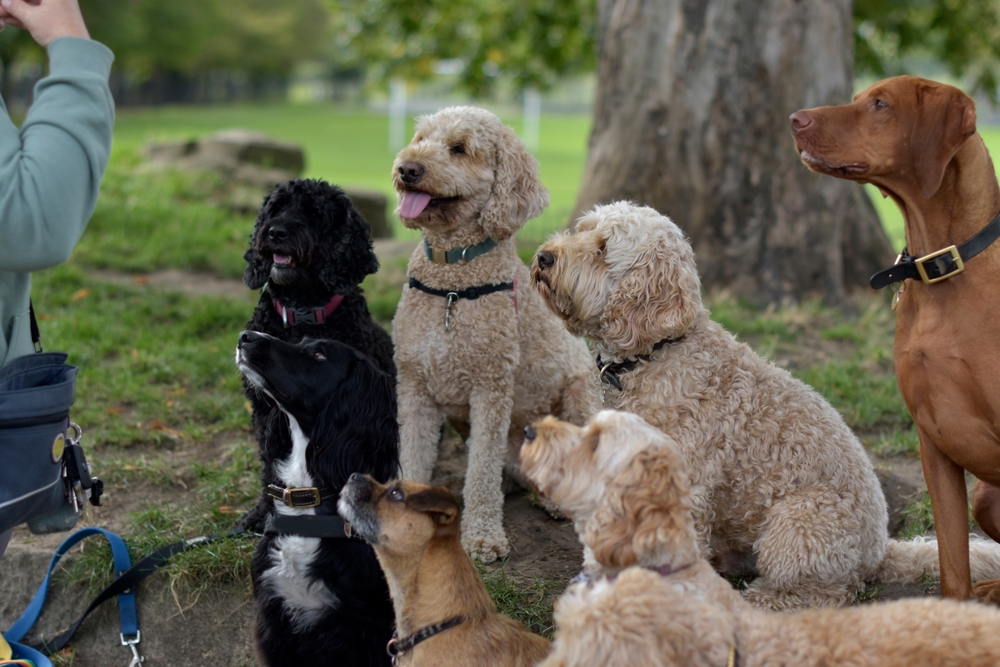No two dogs are the same. Just as people learn differently depending on their age, personality, and experiences, dogs also respond best when training is tailored to their individual needs. A high-energy puppy doesn’t need the same approach as a cautious senior dog, and a bold, curious pup won’t thrive under the same structure as a shy, reserved one. This is why age and temperament dog training is so important—it ensures the program matches your dog’s unique learning style.
At Innovative K9 Academy, we focus on building training plans that respect each dog’s stage of life and personality. Understanding these factors not only makes the process smoother but also creates lasting results that improve both behavior and the relationship between dog and owner.
How a Dog’s Age Impacts Training Approach
Puppies are like sponges. They soak up experiences, good or bad, and this early stage of life is the perfect time to introduce foundational skills. Short, positive sessions work best because puppies have limited attention spans. Training for young dogs emphasizes socialization, bite inhibition, crate comfort, and learning the basics like “sit” and “come.”
Adolescents, often between six months and two years, can be trickier. This stage brings more independence and sometimes stubbornness, much like a teenager. Training must balance consistency with patience, reinforcing good manners while managing testing behaviors.
For adult dogs, training often shifts to maintaining skills, improving reliability, or addressing specific issues like leash reactivity or separation anxiety. Older dogs can absolutely learn new behaviors, but sessions may need to be slower and adjusted for physical comfort. The idea that “you can’t teach an old dog new tricks” simply isn’t true—it just requires the right approach.
Why Temperament Affects Training Style
Temperament is just as critical as age. Two dogs of the same age might need completely different training approaches because of personality. For example:
- Confident, high-energy dogs often benefit from structured exercises that channel energy into productive outlets. Agility or advanced obedience can keep them challenged.
- Shy, cautious dogs require a gentler hand. Rushing training or exposing them too quickly to overwhelming environments can backfire. Building trust and confidence first is essential.
- Independent or strong-willed dogs may push boundaries, so training must emphasize clear communication and consistent follow-through.
- Eager-to-please dogs thrive with positive reinforcement and may advance quickly, but they still need boundaries to avoid overexcitement.
Recognizing temperament ensures the training program doesn’t just address obedience but also builds emotional balance.
Matching Training Programs to a Dog’s Personality
Training is never one-size-fits-all. That’s why initial assessments are so valuable. A trainer can observe your dog’s responses, energy level, and comfort with new situations, then match them to the right program.
For example, a social, energetic Labrador may thrive in group classes where interaction adds to the learning process. On the other hand, a nervous rescue dog may do better in a board-and-train program where structure and individualized attention help build confidence at a slower pace.
At Innovative K9 Academy, we use assessments to design training plans that fit both the dog and the owner’s lifestyle. This ensures progress is steady, realistic, and sustainable.
Examples of Adjusting Training for Different Dogs
To illustrate how much age and temperament matter, let’s look at two scenarios:
- Shy Puppy: A young pup who startles easily at noises may need early exposure to new environments through controlled socialization. The focus should be on positive reinforcement, gradually building comfort with unfamiliar people and dogs.
- Energetic Adolescent: A one-year-old Border Collie bouncing off the walls needs consistent outlets for physical and mental energy. Along with obedience, puzzle toys, structured play, and impulse-control games can prevent frustration and destructive habits.
The right approach for each ensures training doesn’t just teach commands but improves quality of life for both dog and owner.
Importance of Initial Assessment Before Training
Before committing to a program, it’s essential to understand your dog’s baseline. What are their strengths? Where do they struggle? How do they react in new environments? An initial assessment helps uncover the answers.
This step avoids wasted time and frustration by ensuring the training plan is realistic and aligned with your dog’s unique needs. Without it, owners risk treating symptoms instead of causes—like focusing on stopping barking without addressing the underlying anxiety driving it.
An assessment also creates a roadmap for progress, allowing trainers and owners to measure success at each stage.
Why Fixing the Cause Matters More Than Treating Symptoms
Dogs don’t misbehave to annoy their owners. Behavior is communication. Jumping, barking, or destructive chewing often signals unmet needs or an environment that doesn’t fit. Addressing these root causes through age and temperament dog training creates solutions that last.
At Innovative K9 Academy, we focus on helping owners understand the “why” behind behavior. By targeting causes instead of only symptoms, training becomes more effective, compassionate, and rewarding.
Conclusion
Every dog deserves a training approach that respects who they are and where they are in life. Age influences how much structure and patience are required, while temperament shapes the style and pace of training. Whether you have a shy puppy, an excitable adolescent, or a calm senior, tailoring the program ensures better results and a happier dog.
By taking the time to understand your dog’s individuality, you set the stage for lifelong success. With guidance from professionals at Innovative K9 Academy, you can ensure your training journey is customized to bring out the very best in your dog.
If you’re ready to unlock your dog’s potential, explore our approach to age and temperament dog training and see how tailored solutions make all the difference.

